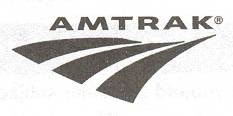 Jacksonville Union Terminal
Jacksonville Union TerminalThis Beau Arts station, designed by Murchison K. Mackenzie (or possibly Kenneth Mackenzie Murchison a New York Architect who was the son of a Confederate Colonel from North Carolina depending upon your source), was opened in 1919 to serve the burgeoning passenger traffic, particularly in the winter, between the frozen north, places like New York City, Cleveland, Chicago and Charleston WV, and the growing balmy beaches on Florida’s “Gold Coast,” Miami, Fort Lauderdale, Palm Beach and the rest. As such, most of the passenger traffic this station saw was “through” traffic. That is to say, in its heyday 85% of the passengers who used this station had arrived from elsewhere and were going to another location. Thus, this was a “Terminal” in name only for the vast majority of the travelers. Jacksonville was not their destination or the point of departure. They were only there to change trains, have their car switched from one train to another, or to use the station’s platforms as a good place to get out and stretch while the train’s operating crew changed and the train was serviced with fuel, water, and all the other items a passenger train needs (contrary to some Congressional expectations) to operate comfortably and efficiently.
The
 first Jacksonville Union Terminal was built in 1904. Interestingly enough, when the 1919 structure was built to replace the by-then inadequate structure, instead of tearing down the old station, it was incorporated into the new structure as a baggage and perishable freight facility. Thus, even today, it sits beside, and in the shadow of, its replacement.
first Jacksonville Union Terminal was built in 1904. Interestingly enough, when the 1919 structure was built to replace the by-then inadequate structure, instead of tearing down the old station, it was incorporated into the new structure as a baggage and perishable freight facility. Thus, even today, it sits beside, and in the shadow of, its replacement.The biggest problem with the Jacksonville Union Terminal was getting the trains into and out of it. Because of its location along the St. John’s River, a location dictated in part by the need to be near the Florida East Coast Railway (FEC), many of the trains coming and going, had to back into the terminal, or, back out when departing. While most of the trains coming in from or going onto the FEC simply pulled through on the station trackage located on the river side of the building, trains from the other lines using the terminal, the Atlantic Coast Line, the Seaboard Air Line, and the Southern Railway (and its subsidiary line The Georgia, Southern and Florida Railroad) were forced to make several inconvenient, and potentially hazardous, switching moves. This awkward situation was compounded when, as a result of labor strife, the FEC stopped all passenger traffic in 1963.
Jacksonville Union Terminal, nevertheless, soldiered on into the early days of Amtrak. It finally closed on January 3, 1974, when Amtrak’s Floridian made the last stop at this facility. The next day Amtrak opened its new facility on the northern outskirts of town.
The new location, is not as convenient to downtow
 n Jacksonville and the Jacksonville Landing as the old Jacksonville Union Terminal. However, it is convenient to the tracks Amtrak uses for its “Silver Service” trains. Further, it allows a “run-through” operation (except when the Sunset Limited ran through Jacksonville on its New Orleans LA to Orlando FL leg). While this new facility has never seen 115 trains and 20,000 passengers, the design capabilities of Jacksonville Union Terminal, it nevertheless can be quite busy in the mornings and again in the evenings. Many times I have had to “wade through” a huge crowd of people in order to board at this new station. It does appear to have some expansion room available so that it could handle more trains and people. However, it does not, IMHO, have as much as might possibly be needed if the “dream” of a high speed rail line up and down the east coast is realized.
n Jacksonville and the Jacksonville Landing as the old Jacksonville Union Terminal. However, it is convenient to the tracks Amtrak uses for its “Silver Service” trains. Further, it allows a “run-through” operation (except when the Sunset Limited ran through Jacksonville on its New Orleans LA to Orlando FL leg). While this new facility has never seen 115 trains and 20,000 passengers, the design capabilities of Jacksonville Union Terminal, it nevertheless can be quite busy in the mornings and again in the evenings. Many times I have had to “wade through” a huge crowd of people in order to board at this new station. It does appear to have some expansion room available so that it could handle more trains and people. However, it does not, IMHO, have as much as might possibly be needed if the “dream” of a high speed rail line up and down the east coast is realized.As for Jacksonville Union Terminal, it has survived to “live another day.” Now it is the key structure in Jacksonville’s Prime F. Osborn III Convention Center. Prime F. Osborn was the last president of the Seaboard Coast Line Railroad and, consequently, the one who led it into the CSX merger.



No comments:
Post a Comment